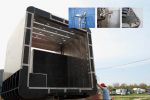The New Smart Grid: 21st Century Tech for the 21st Century
PopSci.com welcomes back Dr. Bill Chameides, dean of Duke’s Nicholas School of the Environment. Dr. Chameides blogs at The Green Grok to spark lively discussions about environmental science, keeping you in the know on what the scientific world is discovering and how it affects you – all in plain language and, hopefully, with a bit of fun. Now, PopSci.com partners with The Green Grok to bring you exclusive new blog posts a week before they hit the Grok's blog. Give it a read and get in on the discussion!
First, a recap of last week's post: In the late 19th century Thomas Edison pushed for a distributed system to deliver electrical power. His dream was never fully realized. Instead, George Westhinghouse’s system designed circa 1891 took shape and forms the structure of today’s grid: a centralized system.
Today’s Grid: What’s Wrong
While it’s based on his vision, Westinghouse might not recognize our current grid -- a vast system of some 16,000 power plants connected by hundreds of thousands of transmission lines carrying electrons to millions. Collectively, every year we consume more than 4,000 million megawatt-hours of electricity (see figure 1 here for a breakdown of energy sources).
We’re used to electricity on demand. We expect the flip of a light switch to produce instant illumination. To accomplish this, we’ve organized our electric grid into three wide-area, synchronous grids: an East, a West, and a Texas grid (it’s special I guess).
Why synchronous? And why not national? It all has to do with that pesky alternating current (AC), in which electrons move back and forth. Here’s the thing - you can’t just plug different power plants, windmills, or regional grids together. For an AC grid to work, all electrons everywhere on it must switch direction at exactly the same time or else it crashes and everyone loses power. Accomplishing this over the entire country would be a tall order given the technologies currently employed. So we synchronize each of the three grids independently and then connect them together using high-voltage direct current (HVDC) trunk lines.
While it’s been enormously successful, many believe that a computerized, adaptive system (a so-called “smart” or “intelligent” grid) could do better. I see four key issues the smart grid could address.
Why We Need a Smart Grid: Four Big Improvements
1. Reliability - Our complex grid involves untold numbers of switches and substations connecting power plants to households and businesses whose electrical demands rapidly fluctuate in time. Unfortunately, the grid is highly sensitive to small variations in voltages and/or the timing in which the electrons change direction (i.e. phase).
Relatively minor events like snowstorms and thunderstorms, can result in local blackouts – not a foreign experience. But when a local failure triggers a cascade of failures, blackouts can roll across entire states – think August 2003.
To address such problems, the smart grid will be “self-healing,” meaning that problems will be detected, isolated, and fixed in real-time with little or no human intervention.
2. Two-Way Interactivity – Current in the grid itself flows in direction – power is sent from plants. The grid doesn’t monitor consumers’ real-time usage (or even their generating contributions from solar cells or wind turbines). To ensure that there’s enough power to meet all needs, power companies always keep excess capacity on hand; this extra electricity is thrown away except on rare instances when demand peaks. Not very efficient. A smart grid would interact with homes and their smart appliances, adjusting power supply and demand in real-time to maximize efficiency while guarding against system overloads.
3. Flexible Transmission System - The current grid is designed for generating facilities typified by coal-fired plants: always operating at or near capacity. It’s Westinghouse’s system. But it’s predicated on a worldview of plentiful energy resources, where inefficiencies and waste are acceptable. That worldview no longer applies. Dwindling fossil fuel supplies and global warming concerns demand renewable energy sources such as wind and solar, resources that tend to be:
- spatially distributed, so unlike coal or natural gas, for instance, electricity must be generated wherever the resource is found; and
- intermittent, so energy storage systems are needed to enable their continuous contribution to the non-stop electrical demands of consumers.
Putting more renewable sources of energy into our current mix (see pie chart) requires a hybrid grid that combines the best features of centralized and distributed systems.
Such a flexible grid would use intelligent systems to handle a wide variety of power sources and storage systems while also maintaining stability.
4. A National Electron Superhighway - Finally, our transmission system must be able to send power efficiently around the nation. Why? Consider wind. The Midwest has much of this potential resource, but people are concentrated on the East and West Coasts. We need a way to get that energy to the people with a minimum of resistive losses. So we must replace outmoded trunk lines (that connect our regional grids) with a single high-voltage transmission line that crosses the nation incorporating nodes along the way that allow individual sub-grids or generating stations to plug in. To minimize resistive losses, this new transmission line will probably be a high-voltage direct current (HVDC) line.
Great Idea but …
It’s easier to talk (or blog) smarter than it is to be (or act) smarter. Building the smart grid poses challenges.
One issue is money. Estimates put smart-grid costs in the ballpark of $65 billion over the next decade or two. The $11 billion from the stimulus package is a start, at best.
Then there’s jurisdiction.
- Regional power companies govern our infrastructure (e.g., Duke Energy, Pacific Gas & Electric Co., Georgia Power Co.);
- Regional transmission organizations or independent system operators coordinate the delivery of power;
- Public utility commissions regulate the distribution and price of electricity within states;
- Roughly half the states have major laws and/or regulations that restructure their electric power industry.
While the need for a smart grid is a national priority, questions of jurisdiction will rise, say, when the installation of a national transmission system is announced and you learn the lines will be strung through you neighborhood.
Ultimately, getting a smart grid is about more than smart technologies; it’s also about figuring out how to be a smart society. The latter might prove to be a lot more difficult.
Bill Chameides
Dean, Duke University
Nicholas School of the Environment|www.TheGreenGrok.com
2 Comments
Popular Tags
The Environment

Featured
The Environment
America's 50 Greenest Cities
Want to see a model for successful and rapid environmental action? Don't look to the federal government—check out your own town. Here, our list of the 50 communities that are leading the way. Does yours make the cut?
Popular on Popsci
Most Viewed
The Environment
- Diving for Ancient History, Scientists Discover New Species
- The Big Melt
- The New Smart Grid: 21st Century Tech for the 21st Century
- Our Grid: Powering Our 21st Century Lives With a 19th Century Design
- Frozen Smoke on the Wastewater
- Getting Climate Science Right
- Green Gadgets? Not So Much
- Quick Fixes for Climate Change
- Green Guitars
- Captain Planet, He's Our Hero, Gonna Take Pollution Down to Zero (Sing it, Kids)
Most Commented
The Environment
- The New Smart Grid: 21st Century Tech for the 21st Century
- Water Vapour Helps Heat Earth
- Diving for Ancient History, Scientists Discover New Species
- The Snake Longer than a School Bus
- Lizard She-Males Get Ahead
- The Green Way to Play Golf
- Teams Chart Under-Ice Mountain
- Researchers Find Primordial Sex
- The Big Melt
- Coral Disease Works Like Cholera
Most Emailed
The Environment
- The New Smart Grid: 21st Century Tech for the 21st Century
- The Big Melt
- Quick Fixes for Climate Change
- Our Grid: Powering Our 21st Century Lives With a 19th Century Design
- Lizard She-Males Get Ahead
- The Green Way to Play Golf
- Teams Chart Under-Ice Mountain
- Researchers Find Primordial Sex
- Coral Disease Works Like Cholera
- Hot Nests Slow Turtle Swimming









Comments
The current grid is a massive waste of energy, and has trouble keeping up with the increasing demand. Hence the numerous balckouts people get when summer hits a country (like those recent hot days in January where power companies in Melbourne and Sydney were forced to shut down some of the grid to avoid a cascade failure).
But also the fact that coal power plants will have to be replaced sometime soon when reserves dry up and the prices dramatically rise. I think that while a lot of effort and publicity is directed towards clean energy sources, more attention should be diverted to the system itself and what can be done to improve its efficiency so as to not waste so much energy.
0 out of 0 people found this comment helpfulI'd say my biggest gripe with the current power grid is the fact that the lines are above ground in the suburban areas. If so much as a branch happens to fall across a couple of the lines, instant blackout! Its most irritating to find yourself without power right at the time you need it most because of something as insignificant as that. And of course, response times can vary from 30 minutes at best to half a day if a series of blackouts were triggered as a result of a surge in the grid.
0 out of 0 people found this comment helpful